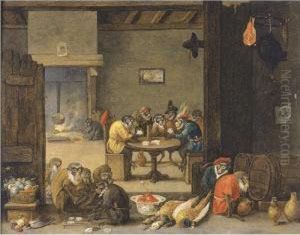Ferdinand Ii Van Kessel Paintings
Ferdinand van Kessel was a Flemish painter who was born on August 24, 1648, in Antwerp. He was part of the well-known van Kessel family of artists, which included his grandfather Jan van Kessel the Elder and his great-uncle Jan Brueghel the Elder. The van Kessel family was renowned for their contributions to the still life and nature genres of painting during the Baroque period in the Southern Netherlands.
Ferdinand van Kessel's father, Jan van Kessel the Younger, was also a painter, and it is likely that Ferdinand received his initial training in art from him. His work was influenced by the attention to detail and the naturalistic representation of flora and fauna that were characteristic of the family's artistic style. Ferdinand van Kessel specialized in painting animals and still lifes, often incorporating both into elaborate and exotic scenes. He was also known for his genre scenes and allegorical representations.
Although not as widely known as other members of his family, Ferdinand's contribution to the Baroque era was significant due to his ability to blend scientific accuracy with artistic creativity. His works often featured a combination of animals and insects in naturalistic settings, and he had a particular talent for capturing the textures and colors of his subjects. This skill made his paintings sought after by collectors who were fascinated by the natural world at a time when scientific exploration was becoming increasingly important in Europe.
Ferdinand van Kessel's paintings can be found in various museums and collections across the world. He died relatively young, at the age of 47, on April 22, 1696, in his hometown of Antwerp. Despite his premature death, his artistic legacy continued through the works of his family and the influence they had on the world of Flemish painting.
